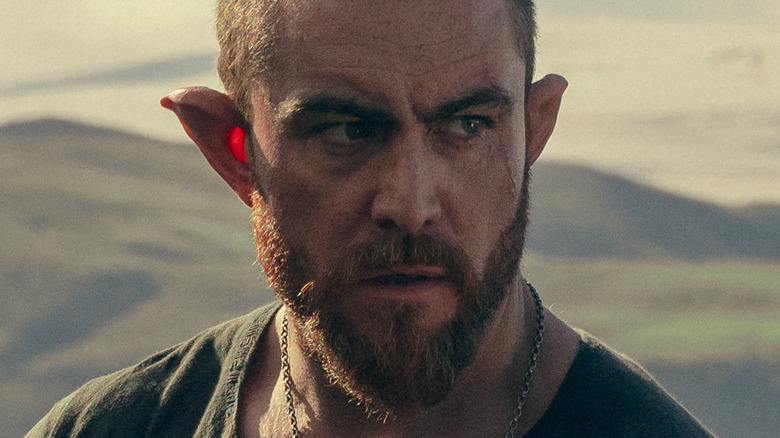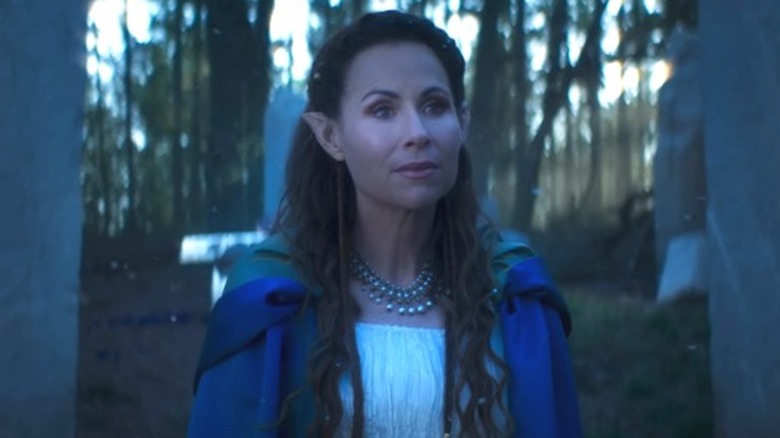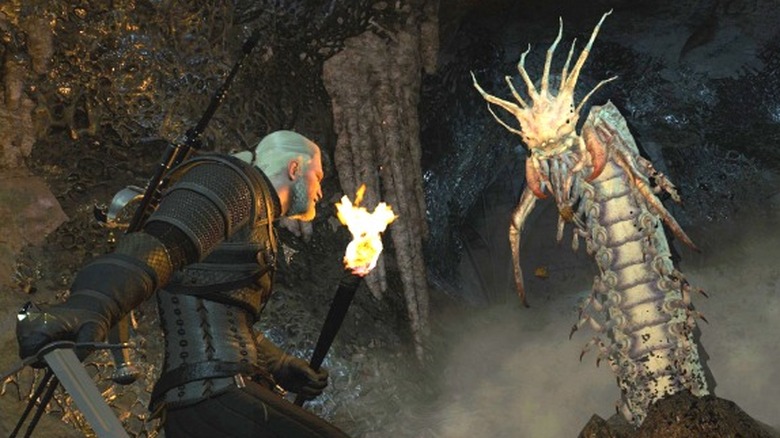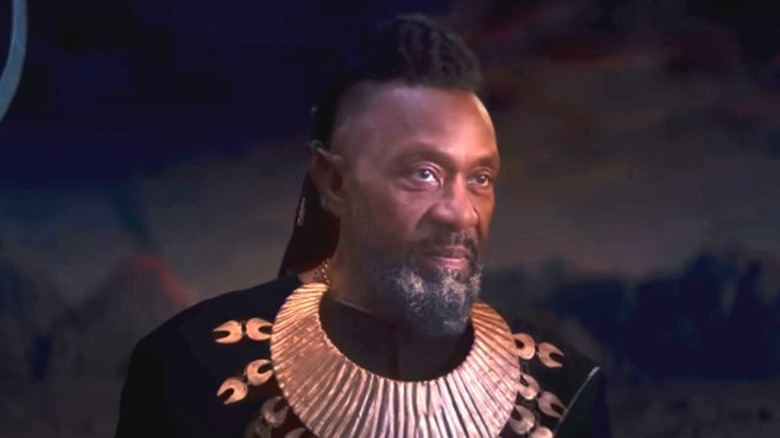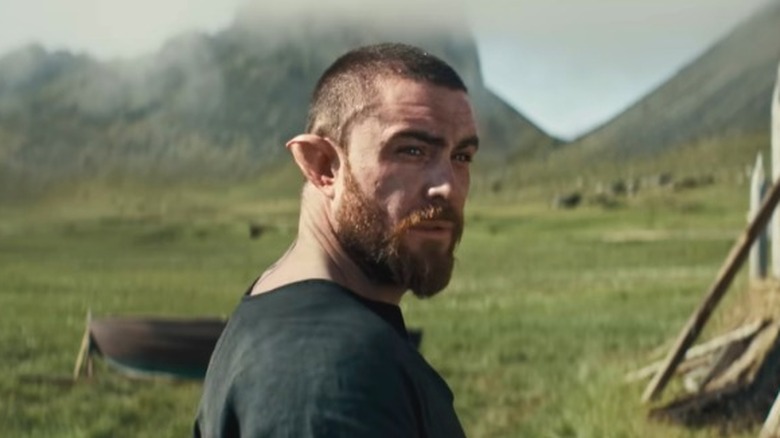All The Monsters In The Witcher: Blood Origin Explained
The following contains spoilers for "The Witcher: Blood Origin" and "The Witcher."
The first spin-off from "The Witcher" franchise on Netflix promises to deliver a story that will attract fans of the books, series, and video games. While the absence of Henry Cavill feels highly conspicuous, this has more to do with the mini-series' setting than with his departure from the primary "Witcher" series (via IndieWire). "The Witcher: Blood Origin" takes place more than a thousand years before the events of the first two seasons of "The Witcher," specifically during a cataclysmic magical event known as the conjunction of the spheres when the opening of numerous portals leads to the arrival of humans and monsters to the continent which, at the time, is only inhabited by dwarves and elves.
"Blood Origin" introduces audiences to a world where elven empires are built through alliances, betrayals, and war; the only threats to elven supremacy are the bandit attacks and famine brought by the chaos of conflict. As the events unfold, both characters and viewers see some of the first monsters to enter this realm. And while in the world of "The Witcher," most creatures tend to follow strict categories like insectoids, draconids, specters, and relics, some of the monsters presented in "Blood Origin" defy any classification. The lack of information regarding these creatures adds to the sense of mystery and discovery of the story. However, as obscure as their nature may seem, their roles in "Blood Origin" and possibly future seasons of "The Witcher" are more than evident. Here are all the monsters in "The Witcher: Blood Origin."
Seanchai
Played by "Good Will Hunting" star Minnie Driver, Seanchai doesn't give us many clues regarding her nature. Her first action is to save Jaskier on a battlefield after freezing the soldiers in time. Seanchai later emerges from the shadows looking like Jaskier himself, only to switch to a monstrous appearance and finally take the form of an elf in order to calm the bard. She denies being a Doppler or a shape-shifter, but she clearly has very similar abilities. At the same time, Seanchai seems to have some level of control over time and — as Driver herself said on Twitter – space. The actress sees her character as a collector of stories — someone who retrieves long-forgotten tales and brings them back to musicians to share with people when they need them the most.
Telling Jaskier the story behind the conjunction of the spheres and the creation of the first witcher may not seem to have a clear purpose unless we connect it with the events that take place in Season 2 of "The Witcher." During this time, several monoliths are used to open portals to other worlds. This frequently leads to several monsters crossing into the continent and wreaking havoc. Their arrival is expected to bring even more chaos to this world — after all, the first conjunction of the spheres leads to the end of elven rule as well as to the creation of witchers. With such desperate times waiting for them in the future, the different inhabitants of the continent may need to remember how this all began in the first place and learn that they should remain hopeful regardless of the chaos. In that sense, Jaskier's new song may just become the most powerful weapon at their disposal.
Pale Widow
Most monsters in "The Witcher" are based on real folklore. The Doppler, for example, is a variation of a mythological creature from Finland and Ireland. The djinn, on the other hand, comes from ancient Middle Eastern folklore (via Time). Nevertheless, some creatures have a much simpler nature. Monsters like the Arachnomorph and the Endrega look like overgrown spiders and scorpions, and something very similar happens with the giant centipede — a creature that is referred to in the books. The giant centipede makes an appearance in Season 2 of "The Witcher," although with drastic changes to its design, and it's a common enemy in "The Witcher III: Wild Hunt."
In "The Witcher: Blood Origin," the heroes encounter their first monster while opening a portal to approach the city of Xin'Trea. They enter a new world, not very different from their own, except for its inclusion of a beautiful flower that ends up luring a giant white centipede, which proceeds to hunt them. They manage to escape by jumping back to their world and closing the portal while the creature is still crossing. The Pale Widow is probably one of the few monsters in "Blood Origin" that's easily identifiable as it's part of the bestiary of "The Witcher III: Wild Hunt." Despite its relatively simple nature, however, it ends up becoming an important resource for the heroes, increasing their chances of victory and changing one of them forever.
Balor's Monster
Probably the most intriguing creature in the mini-series, the monster brought by Balor from another world is very difficult to classify. It has insect-like legs and wings, can fly, has the shape of a dragon, and shoots lightning capable of turning people into mist from its three arrowhead-shaped tails. It's this ability that allows Balor to execute the king and the heads of most warrior clans almost instantly — paving the way for his allies to take over the empire. As a result, both the empress and her soldiers adopt the three arrowhead-shaped tails as their coat of arms and wear them on their armors. However, the confidence in their capacity to control anything on the other side of the portals proves to be their greatest weakness.
Balor's monster eventually falls and becomes the first monster to be slayed by a witcher. But having tasted the power of chaos magic, Balor sacrifices Fenrik, the only person he cares about, to acquire an immense amount of power. When he returns to the palace, though, he tests his new abilities on Syndril and Zacaré, who use their power to redirect the energy to the monolith, destroying it in the process. Tragically, rather than solve their problems, this causes multiple portals to open — an event known in the books as the conjunction of the spheres, leading to the arrival of both humans and monsters to the continent. This is the end of the empress' delusions of conquering other worlds and, eventually, the destruction of elven civilization.
Fjall: The first witcher
The process of creating a witcher is complex and intensely painful. Prospects go through a series of chemical treatments that leave them infertile and relatively emotionless. On the plus side, the process also grants them enhanced sight, resistance to poisons and illnesses, increased agility and strength, and the ability to wield a small but useful level of magic. Some of these changes may seem random, but one of the things "Blood Origin" makes clear is how necessary some of these features are when creating the perfect monster slayer.
Finding themselves in close proximity to the empress' castle, but with no way in, Fjall turns to a dangerous ritual that uses potions and spells to fuse his body with a slain monster. The painful process almost takes his life, but also gives him enormous strength, as well as a high level of aggressiveness and a deep desire to hunt. When he's finally brought to the castle, he loses control after seeing Éile being hurt by Balor's creature. This puts him in a sort of berserker state where his skin turns gray and his muscle mass grows to monstrous levels. He uses this strength to slay the creature, but he loses control of his emotions and ends up attacking his friends who are forced to kill him.
In the books, the origin of the first witcher is a bit different. As Winteriscoming.net explains, witchers are the result of mutations obtained through multiple experiments with monsters. It's possible that these mutations would probably include the effect of reducing the intensity of the witcher's emotions, something necessary to turn them from berserker creatures into self-aware monster slayers. This aspect of the source material could be explored in an eventual sequel to "Blood Origin." (via Entertainment Weekly).
